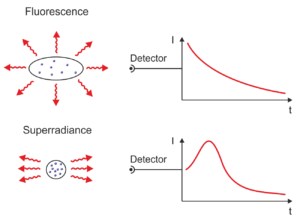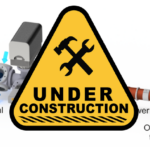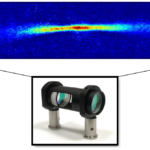Working on this experiment:
PhD students: Marvin Proske, Ishan Varma, Rhuthwik Sriranga
Master students: Dimitra Cristea, Chung-Ming Hung
Contents
Introduction
A common approach to describe light scattering in atomic samples is to assume that atoms are scattering independently from each other. However, light propagation behaves distinctively different in dense atomic samples, where the interatomic distance is smaller than the wavelength of the interacting light. In these cases, recurrent scattering of photons induces electric dipole-dipole correlations in the sample, influencing the spatial correlations of the scatterers. On the other hand, spatial correlations, which may be induced by other interaction processes, can alter the light propagation properties of the ensemble.
We are interested in the interplay between light-induced and magnetic dipole-dipole interactions of atoms with large magnetic moments. Since both interaction processes result in spatial correlations, we expect to find regimes in which both processes become competing. In this project we are working towards experimental studies of light-induced correlations in such dipolar media made from dense samples of laser cooled and trapped dysprosium atoms, the most magnetic atoms on the periodic table.
Light induced correlations
T he scattering of light from atoms, for which the separation is smaller than the wavelength of the interacting light, can no longer be assumed independent for each atom. Instead, the emission of an atom is influenced by every other atom in the dense sample. An interesting phenomenon emerging from this situation is superradiance. The figure beneath summarizes essential properties of superradiance and compares those to conventional fluorescence. In fluorescence, the emission of light from a dilute sample of excited atoms can be described by an exponential decay law. The emission is isotropic, which is a fundamental property required for laser cooling. In superradiance, on the other hand, the emission from the dense atomic sample occurs in a short burst of light. Furthermore, one can observe directionality in the emission.
he scattering of light from atoms, for which the separation is smaller than the wavelength of the interacting light, can no longer be assumed independent for each atom. Instead, the emission of an atom is influenced by every other atom in the dense sample. An interesting phenomenon emerging from this situation is superradiance. The figure beneath summarizes essential properties of superradiance and compares those to conventional fluorescence. In fluorescence, the emission of light from a dilute sample of excited atoms can be described by an exponential decay law. The emission is isotropic, which is a fundamental property required for laser cooling. In superradiance, on the other hand, the emission from the dense atomic sample occurs in a short burst of light. Furthermore, one can observe directionality in the emission.
Collective light-scattering phenomena, like superradiance, can be understood by the coherent synchronization of the radiating atoms. This can be caused by the recurrent scattering of photons, leading to a build-up of spatial order in the sample. In the course of this project, we want to study these light-induced correlations in samples, in which spatial correlations may be governed by a strong magnetic dipole-dipole interaction.
Dysprosium

The atomic species for our experiments is dysprosium (Dy) which, with an atomic number of Z = 66, belongs to the group of rare-earth lanthanides. It is a silvery grey metal with large atomic mass (162.5 u) and a high melting point of ~1400 °C. Dysprosium features several stable isotopes, the most abundant being the two bosonic isotopes 162Dy and 164Dy and the two fermionic ones 161Dy and 163Dy with nearly equally high natural abundances. Both bosonic isotopes possess a nuclear spin equal to zero (I=0) whereas the fermions have a nuclear spin of I = 5/2. The almost equally high relative abundances of these four isotopes allow for the generation of Bose-Einstein-Condensates, ultra-cold Fermi Gases and Bose-Fermi-mixtures.
 The electronic ground-state configuration of Dy is [Xe]4f106s2, with spin S = 2, orbital angular momentum L = 6 and total angular momentum J = 8. This open f-shell configuration leads to a very rich and complicated energy spectrum with a variety of atomic transitions that are suitable for laser cooling and performing light-matter interaction experiments. More importantly, it is the origin of Dy’s large ground-state magnetic moment which, with a value of about 10 Bohr-magnetons (µ~10μB), is the largest magnetic moment of all elements in the periodic table. Compared to alkali atoms (µ~1μB) the dipole-dipole interaction for Dy atoms is about 100 times stronger.
The electronic ground-state configuration of Dy is [Xe]4f106s2, with spin S = 2, orbital angular momentum L = 6 and total angular momentum J = 8. This open f-shell configuration leads to a very rich and complicated energy spectrum with a variety of atomic transitions that are suitable for laser cooling and performing light-matter interaction experiments. More importantly, it is the origin of Dy’s large ground-state magnetic moment which, with a value of about 10 Bohr-magnetons (µ~10μB), is the largest magnetic moment of all elements in the periodic table. Compared to alkali atoms (µ~1μB) the dipole-dipole interaction for Dy atoms is about 100 times stronger.
Experimental setup
Cooling and trapping of dysprosium is realized in several sequential steps. Initially the Dy atoms are evaporated in a high temperature effusion cell (EC). Due to its high melting point, temperatures of about 1200°C are needed to evaporate a sufficient number of dysprosium atoms for our experiments. As a result of these high temperatures, Dy atoms are leaving the effusion cell with a very high velocity of about 500 m/s. The atomic beam is then collimated by a set of apertures and transversally cooled (TC) to reduce the beam divergence. The next cooling step is done inside a Zeeman slower in which the atoms are slowed down to mean velocities of about 15 m/s. In a Zeeman slower a spatially varying magnetic field is combined with a laser beam to realize one-dimensional laser cooling. After being precooled in the Zeeman slower, the atoms will be trapped inside a magneto-optical trap (MOT), where they are further cooled to temperatures in the micro Kelvin range. This allows for the transfer into an optical dipole trap (ODT) that confines the atoms and enables us to transport them into a home-built science cell by moving the focus with optics mounted on an air-bearing translation stage. After the atoms are optically transported into the science cell, they will be retrapped utilizing a microscopic ODT. The resulting dense cloud will then be probed for signatures of collectivity in the optical response by light-scattering processes. In the future, quantum degeneracy can be achieved by evaporative cooling of the atoms in the ODT.
Our experiment utilizes the blue transition at 421 nm for transverse cooling, the Zeeman slower and for absorption imaging, while the MOT is operated on the narrow orange 626 nm transition. The ODT for transport and retrapping is generated by a high power 1064 nm laser system. An ultra-high vacuum chamber is required to cool, trap and investigate ensembles of Dy atoms.
Publications
Nico Baßler, Ishan Varma, Marvin Proske, Patrick Windpassinger, Kai-Phillip Schmidt, Claudiu Genes
Cooperative effects in dense cold atomic gases including magnetic dipole interactions
Phys. Rev. Research 6 023147 (2024), arXiv:2306.11486
Niels Petersen, Marcel Trümper, Patrick Windpassinger
Spectroscopy of the 1001 nm transition in atomic dysprosium
Phys. Rev. A 101 042502 (2020), arXiv:1907.05754
Niels Petersen, Florian Mühlbauer, Lykourgos Bougas, Arijit Sharma, Dmitry Budker and Patrick Windpassinger
Sawtooth wave adiabatic passage slowing of dysprosium
Phys. Rev A 99 063414 (2019), arXiv:1809.06423
Dominik Studer, Lena Maske, Patrick Windpassinger and Klaus Wendt
Laser spectroscopy of the 1001nm ground state transition in dysprosium
Phys. Rev. A 98 042504 (2018), arXiv:1807.07903
Florian Mühlbauer, Niels Petersen, Carina Baumgärtner, Lena Maske, Patrick Windpassinger
Systematic optimization of laser cooling of dysprosium
Applied Physics B 124:120 (2018), arXiv:1804.01938
Bachelor / Master Theses
We always offer projects both for bachelor and master theses. At the moment, following projects are available in our lab:
- Setup and characterization of a high numerical aperture lens system for trapping and imaging of atomic clouds
For imaging and trapping of microscopical atomic clouds, a high numerical aperture lens system is required. Your task is the design, setup and characterization of such a system. - Characterization of a trapping and transport system for cold atoms
Our plan is to transport cold Dysprosium atoms from our magneto-optical trap into a separate science chamber utilizing a dipole trap. Your task would be the implementation, characterization and optimization of the atomic transport mechanism. - Characterization of a magnetic field compensation system
Our work towards light-induced correlations requires a precise control of the magnetic field. Due to its large magnetic moment, Dysprosium exhibits a strong interaction with interfering magnetic fields. Your task would be the characterization of a magnetic field compensation system that surrounds the experimental apparatus. - Initial studies on light-induced correlations
Assist in designing and performing our very first experiments to study light-induced correlations in dipolar media from dysprosium!
If you are interested in joining our team as a bachelor or master student, please contact Prof. Patrick Windpassinger or PhD students Marvin Proske and Ishan Varma.
Finished Theses
Gezielte Kontrolle der Schaltzeit von Laserlicht, bachelor thesis by Stefanie Kirschner (2023)
An Optical Transport System for Ultracold Dysprosium, master thesis by Nivedith K. Anil (2023)
Performance characterization of a microtrap objective for cold atom experiments, bachelor thesis by Dimitra Cristea (2023)
Aufbau und Charakterisierung einer optischen Dipolfalle für Dysprosium, bachelor thesis by Hannah Jost (2021)
Generation of Higher Order Laser Beams Using a Spatial Light Modulator, bachelor thesis by Natalija Sheth (2021)
Laserintensitätsstabilisierung mit dem Red Pitaya, bachelor thesis by Jonas Lehnen (2018)
Aufbau und Charakterisierung einer optischen Dipolfalle für Dysprosium, bachelor thesis by Gunther Türk (2018)
Spektroskopie des 1001nm Übergangs von Dysprosium, master thesis by Lena Maske (2018)
Laserkühlen von Dysprosium, master thesis by Carina Baumgärtner (2017)
Summenfrequenzerzeugung von 626 nm Laserlicht, bachelor thesis by Lena Maske (2016)
Aufbau und Stabilisierung eines ECD-Lasers, bachelor thesis by Ansgar Schaefer (2015)
News from the Dysprosium-Lab – FB 08 – Experimental Quantum Optics and Quantum Information
 We are currently setting up an extension to our current vacuum chamber, which allows us to create even denser clouds of ultracold Dysprosium.
We are currently setting up an extension to our current vacuum chamber, which allows us to create even denser clouds of ultracold Dysprosium.
A list of possible Bachelor/Master theses surrounding the current work can be found above.
 Our first approach to create dense Dysprosium samples with a self-designed objective was succesful in creating microscopic Dysprosium clouds with a width of less than 10μm. In the future, this can be improved on with a science cell that allows for even tighter dipole trapping!
Our first approach to create dense Dysprosium samples with a self-designed objective was succesful in creating microscopic Dysprosium clouds with a width of less than 10μm. In the future, this can be improved on with a science cell that allows for even tighter dipole trapping!
 Our project got accepted into QuCoLiMa! In the future, we plan to investigate collective effects in high density Dysprosium samples.
Our project got accepted into QuCoLiMa! In the future, we plan to investigate collective effects in high density Dysprosium samples.
More information on QuCoLiMa and our project C02 can be found here: QuCoLiMa.de.
 During extensive spectroscopic efforts we finally found and characterized the ultra-narrow 1001 nm ground state transition in dysprosium. We determined lifetime and polarizability of the excited state and measured the isotope shifts for the isotopes 160Dy, 162Dy and 164Dy.
During extensive spectroscopic efforts we finally found and characterized the ultra-narrow 1001 nm ground state transition in dysprosium. We determined lifetime and polarizability of the excited state and measured the isotope shifts for the isotopes 160Dy, 162Dy and 164Dy.
A preprint of our paper can be found here: https://arxiv.org/abs/1907.05754.
 Our Optical Dipole Trap (ODT) is now operational, which is generated from a high power 1064 nm laser system.
Our Optical Dipole Trap (ODT) is now operational, which is generated from a high power 1064 nm laser system.
 Recently, we measured the spectrum of dysprosium on the 421 nm cooling transition with our homebuilt laser system. After amplifying the master laser seed in a homebuilt tapered amplifier stage, it is frequency doubled in a homebuilt bow tie cavity which delivers up to 460 mW of blue laser power. The five most abundant isotopes of dysprosium can clearly be identified in the spectrum shown below. The inset shows a picture of our main vacuum chamber where a beam of dysprosium atoms crosses the spectroscopy beam
Recently, we measured the spectrum of dysprosium on the 421 nm cooling transition with our homebuilt laser system. After amplifying the master laser seed in a homebuilt tapered amplifier stage, it is frequency doubled in a homebuilt bow tie cavity which delivers up to 460 mW of blue laser power. The five most abundant isotopes of dysprosium can clearly be identified in the spectrum shown below. The inset shows a picture of our main vacuum chamber where a beam of dysprosium atoms crosses the spectroscopy beam


